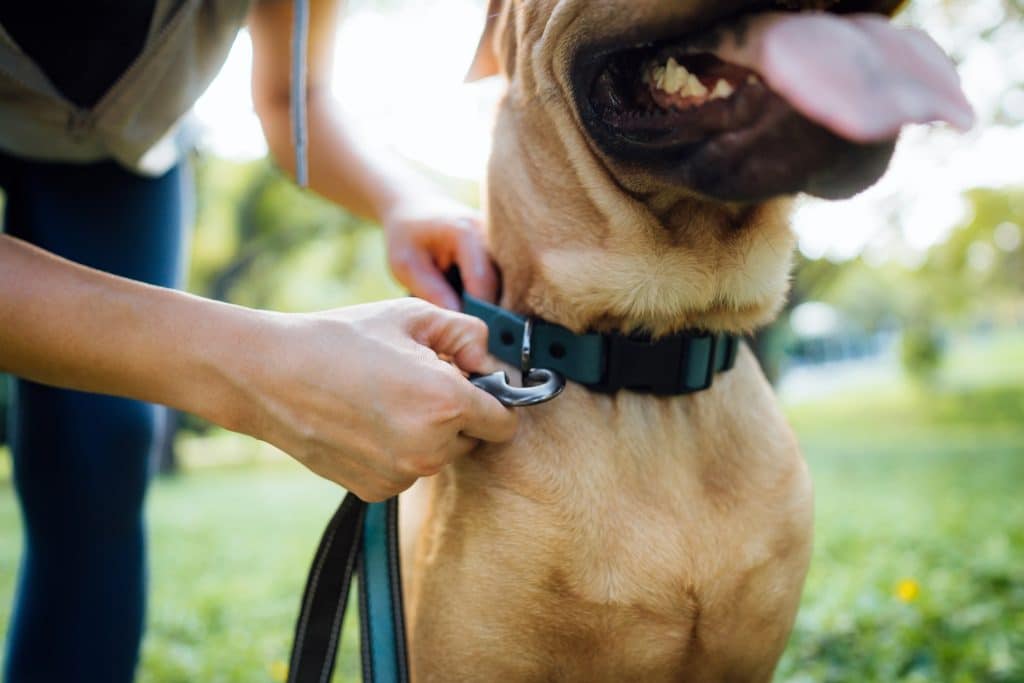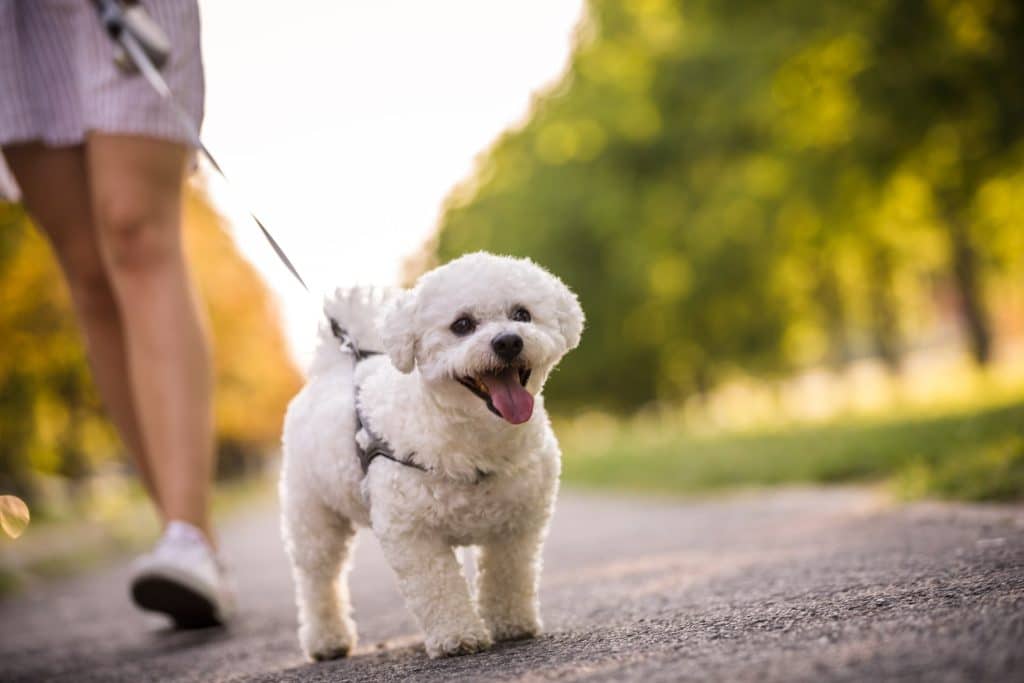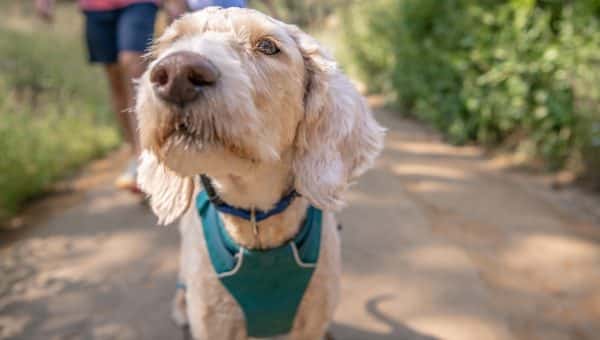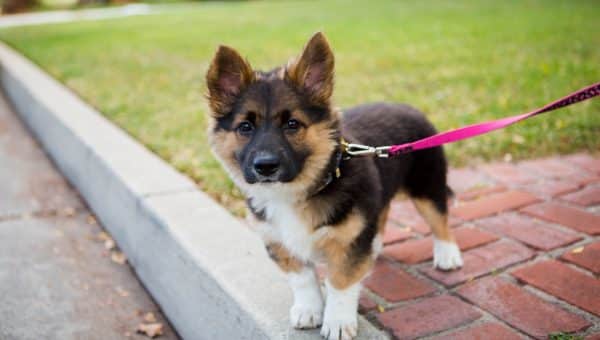- This post contains affiliate links. Read more here.
- Not a substitute for professional veterinary help.
Dogs and walks go hand in hand. If you struggle to keep up with your dog’s walking needs for one reason or another, hiring a dog walker is a smart way to keep your pup happy and healthy. Fortunately, plenty of options are available today, from app-based dog walking services to professional off-leash walkers. Generally, the best way to prepare your dog for a walker includes prioritizing socialization, investing in basic training, and getting proper fitting equipment.
However, not every type of dog walker is right for every dog. In this guide, we’ll look at the different types of dog walking services available to help you choose one that suits your pup’s personality and level of training. We’ll also discuss how to prepare your dog for their dog walker to ensure a positive experience for everyone.
1. Train Your Dog For a Walker Beforehand
No matter what type of dog walker you hire, they’ll appreciate a well-mannered pup with some basic training under their belt. Here are some skills to work on.
Practice basic cues
“Before hiring a dog walker, your dog should have strong recall skills and foundational cues such as ‘sit’ and ‘leave it,’ which will help prepare your dog for on-leash walking,” says Darris Cooper, CPDT-KA, FFCP, National Dog Training Manager at Petco. If you’re stuck, a virtual training app like GoodPup can offer dog training tips to get your dog walk-ready. Focus on the following cues.
- Come: Mastering proper recall is crucial for safety. If your dog accidentally gets loose, it can prevent them from running towards potential dangers like traffic or another dog.
- Sit: Understanding “sit” comes in handy when waiting to cross the street. Keeping dogs still and calm while greeting other walkers is also practical.
- Stay: This cue builds impulse control and prevents dogs from dashing into the street if they get off the leash.
- Touch and leave it: The cues “touch” and “leave it” can bring your dog back to you when they’ve wandered too far away. “Touch” brings your dog’s nose—and their body along with it—to touch your hand, and “leave” has your dog move away from a scent or other attention-grabbers.
Play the red-light-green-light game
This game is a great way to curb pulling and practice loose-leash walking. However, experts say it only works with puppies—not adult dogs who are already pulling.
When your puppy pulls on the leash, stop moving and wait for them to stop. When they are loose on the leash, start walking again.
2. Buy & Familiarize Your Dog With the Correct Walking Gear
Generally, avoid breaking out brand-new gear on your dog’s first outing with a walker. “Dogs should always be properly acclimated to equipment before using them for a walk,” says Brett Reynolds, a certified Fear-Free dog trainer and owner of The Dog Stop. This will make your dog more comfortable and ensure a proper fit.
As Cooper explains, different dogs will require different gear depending on their breed and temperament. Some of this gear includes:
- Leash: A 4-6 foot leash offers control and communication between the walker and the dog. Reynolds recommends a fixed-length leash (not retractable) for safety. Material-wise, nylon, and leather are two durable options that hold up well to strong pullers.
- Harness: Both of our experts recommend a harness to make walks more manageable. “Front-clip harnesses such as the Easy Walk or Freedom No-Pull harness can reduce pulling without being aversive to the dog,” Reynolds says. If your dog bolts, an escape-proof harness with multiple points of adjustment, sturdy materials, and additional straps can keep them safe.
- Collar: Even if they wear a harness, your dog should wear a collar to hold their ID tags. Standard nylon collars will work for most dogs. Consider a martingale collar if your dog slips out of a traditional collar.
- Head collar: Haltis and Gentle Leaders give handlers better control—but they come with a learning curve and require a period of acclimatization.
- Poop bags: Don’t leave your walker stranded without a way to dispose of your dog’s “treasures.” A poop bag holder ensures bags are at the ready whenever nature calls.
- Training treats: Cooper and Reynolds say these are helpful for rewarding and reinforcing good behavior on walks.
- Dog water bottle: If your dog goes on long walks, Cooper recommends a travel water bottle for hydrating on the go.

iStock/AsiaVision
3. Choose The Right Dog Walker
With the rise of online and app-based services, dog walkers are more accessible than ever. Today, there are four main types of dog walkers to choose from, and some will work better for your dog than others. Here’s how you can prepare your dog for every type of walker.
Online dog walker
Apps and sites like Rover virtually connect pet parents with walkers and sitters. You can browse the profiles of dog walkers in your area and book them in advance for regular and occasional outings.
To help you find the perfect walker for your particular needs, Rover lets you look at their qualifications and reviews before making a selection. You can also set up an advance meeting to introduce your pup and make sure the walker is comfortable with them. Scheduling a meet and greet is a great first step, especially if your dog is fearful, reactive, or extra-large.
Most dogs will be more at ease meeting a new walker for the first time with their guardian present. Note how the walker and your dog interact with each other. A good walker will be attentive, warm, and patient with excitable behavior. Your dog should also appear content and comfortable in their presence.
Lastly, if your schedule allows, try walking your dog at the same time as your potential new walker.
On-demand dog walker
These days, just about everything is available on-demand—walks for your dog are no exception. Just like ride-sharing apps, an on-demand dog walking service will send over the closest available walker to take your pup out.
The best candidates for on-demand walking will be confident, easy-going dogs comfortable with everyone. However, if your dog is anxious or reactive, it’s probably better to go with a professional dog-walking service.
- Make sure your dog is easily accessible. Give your walker a spare key, or leave it in a lock box. Ensure the keys are easy to use—you don’t want your walker to become distracted when struggling with a fiddly door.
- Leave everything your walker needs in one easy-to-find spot. This includes your pup’s leash, poop bags, and treats.
- Provide detailed instructions. Most apps let you leave info about parking, how to access your home, and pertinent details about allergies, medical conditions, or behavior issues walkers should know about.
Professional dog walking service
A professional dog walking service is worth considering if you’re looking for a more permanent solution. You can find local pros through a quick internet search or via referrals from friends or your veterinarian. In most cases, these companies will be insured and bonded, and walkers will often be trained in CPR and dog first aid.
Professional on-leash dog walkers may offer group walks, solo walks, or walks with only one or two other individuals. If your dog doesn’t do well in large groups of dogs, talk about this with the service provider in advance.
Professional off-leash dog walker
Professional dog walkers typically offer two kinds of off-leash walks: those who take their pack of four to ten dogs to an open off-leash space and those who take them to an enclosed dog park.
For safety and legal reasons (most states enforce mandatory leash laws), our experts caution against off-leash walks. “If pet parents want their pup to be off-leash, it’s important to do so in an enclosed, safe environment such as a fenced-off yard or dog park,” Cooper explains.
Well-trained, nonaggressive dogs with impeccable recall may do well with off-leash walking in an enclosed area. Should you go this route, your most important prep work will be sharpening up your dog’s ability to come when called.
Pro-tip: Use a long line—a 30-ft leash—with your dog in a park or fenced yard to practice recall. The best long leashes will be made with durable materials and strong metal clasps to keep dogs secured.
Reynolds tells us that dog walkers who offer off-leash walks should be well-versed in strategies to recall loose dogs. “One should never chase a dog, but rather run backward and call the dog in a cheerful, enthusiastic manner and reward generously with treats and praise when the dog returns,” he adds. If coming to you results in praise and a treat, they’ll be more likely to come to you in the future.
4. Socialize Your Dog With Other Dogs & Strangers
Inviting a stranger into your home could stress your dog out. Before hiring a dog walker, ensure your pup feels at ease when new people enter the home or when they’re around strangers outside. Here are some surefire ways to socialize your dog pre-walker:
- Consider your dog’s breed: Some dog breeds are more amenable to socializing with strangers than others. These friendly dog breeds include Labrador Retrievers, Beagles, Bernese Mountain Dogs, and Golden Retrievers.
- Keep an eye on your dog’s body language: Dogs can’t tell us how they’re feeling; instead, pay attention to their body language when bringing new folks into your home, including potential walkers. If your dog’s stressed, it’s time to dial back.
- Stay positive: When introducing your dog to other dogs or strangers, keep positive reinforcement tactics at the top of your mind; give your pup training treats and praise if they act calm around other dogs.

iStock/fotostorm
The Bottom Line: You Know Your Dog Best
You’ll find the most success by matching your dog’s temperament and abilities to the appropriate type of walker. A bit of training and securing the right walking equipment are also important factors. The Rover app simplifies the entire process by letting you search for local dog walkers who meet your specific criteria. Happy walking!





